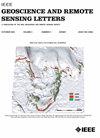Unsupervised Classification of PolSAR Data Using a Scattering Similarity Measure Derived From a Geodesic Distance
IF 4
3区 地球科学
Q2 ENGINEERING, ELECTRICAL & ELECTRONIC
引用次数: 33
Abstract
In this letter, we propose a novel technique for obtaining scattering components from polarimetric synthetic aperture radar (PolSAR) data using the geodesic distance on the unit sphere. This geodesic distance is obtained between an elementary target and the observed Kennaugh matrix, and it is further utilized to compute a similarity measure between scattering mechanisms. The normalized similarity measure for each elementary target is then modulated with the total scattering power (Span). This measure is used to categorize pixels into three categories, i.e., odd-bounce, double-bounce, and volume, depending on which of the above scattering mechanisms dominate. Then the maximum likelihood classifier of Lee et al. based on the complex Wishart distribution is iteratively used for each category. Dominant scattering mechanisms are thus preserved in this classification scheme. We show results for L-band AIRSAR and ALOS-2 data sets acquired over San Francisco and Mumbai, respectively. The scattering mechanisms are better preserved using the proposed methodology than the unsupervised classification results using the Freeman–Durden scattering powers on an orientation angle corrected PolSAR image. Furthermore: 1) the scattering similarity is a completely nonnegative quantity unlike the negative powers that might occur in double-bounce and odd-bounce scattering component under Freeman–Durden decomposition and 2) the methodology can be extended to more canonical targets as well as for bistatic scattering.基于测地线距离的散射相似度量的PolSAR数据无监督分类
在这封信中,我们提出了一种利用单位球面上的测地距离从极化合成孔径雷达(PolSAR)数据中获得散射分量的新技术。该测地线距离是在基本目标和观测到的肯诺矩阵之间获得的,并进一步用于计算散射机制之间的相似性度量。然后用总散射功率(Span)调制每个基本目标的归一化相似性度量。该度量用于将像素分为三类,即奇数反弹、双反弹和体积,这取决于以上散射机制中的哪一种占主导地位。然后对每个类别迭代使用Lee等人基于复杂Wishart分布的最大似然分类器。因此,在该分类方案中保留了主要的散射机制。我们展示了分别在旧金山和孟买获得的L波段AIRSAR和ALOS-2数据集的结果。与在方位角校正的PolSAR图像上使用Freeman–Durden散射功率的无监督分类结果相比,使用所提出的方法更好地保留了散射机制。此外:1)散射相似性是一个完全非负的量,不同于Freeman–Durden分解下双反弹和奇反弹散射分量中可能出现的负幂;2)该方法可以扩展到更规范的目标以及双基地散射。
本文章由计算机程序翻译,如有差异,请以英文原文为准。
求助全文
约1分钟内获得全文
求助全文
来源期刊

IEEE Geoscience and Remote Sensing Letters
工程技术-地球化学与地球物理
CiteScore
7.60
自引率
12.50%
发文量
1113
审稿时长
3.4 months
期刊介绍:
IEEE Geoscience and Remote Sensing Letters (GRSL) is a monthly publication for short papers (maximum length 5 pages) addressing new ideas and formative concepts in remote sensing as well as important new and timely results and concepts. Papers should relate to the theory, concepts and techniques of science and engineering as applied to sensing the earth, oceans, atmosphere, and space, and the processing, interpretation, and dissemination of this information. The technical content of papers must be both new and significant. Experimental data must be complete and include sufficient description of experimental apparatus, methods, and relevant experimental conditions. GRSL encourages the incorporation of "extended objects" or "multimedia" such as animations to enhance the shorter papers.
 求助内容:
求助内容: 应助结果提醒方式:
应助结果提醒方式:


